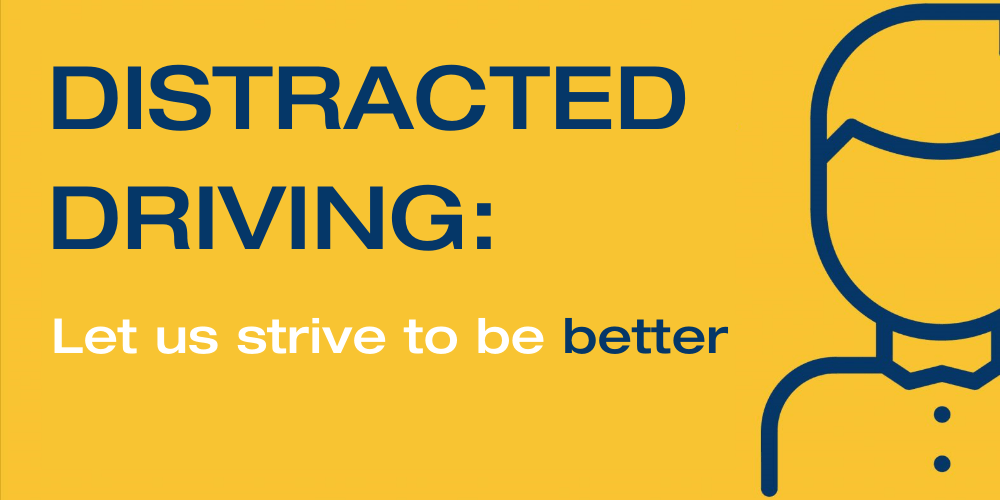Distracted Driving: Let Us Strive to Be Better.
What is distracted driving?
Distracted driving is defined as partaking in an activity behind-the-wheel that takes away from your responsibility of driving safely. Distractions can occur both inside and outside of your vehicle.
There are many statistics about distracted driving but think about this, there were 3,142 distracted driving fatalities in 2019 (a 9.9% increase from 2018), according to NHTSA. This means more people are getting behind the wheel of a vehicle and are not dedicating 100% of their efforts to driving safely. The next time you drive, consider the possibility that all drivers around you are engaged in some type of distraction and therefore are not driving responsibly.
What are the types of distracted driving?
All distractions can be categorized as visual, manual, cognitive, or a variation of the three.
- Visual distractions cause you to take your eyes off the road.
- Manual Distractions cause you to take your hands off the wheel.
- Cognitive distractions cause you to take your mind off the task of driving.
What are some reasons you may take your eyes off the road?
Briefly adjusting vehicle controls, looking in your mirrors, and reading road signs are necessary components of driving. Be mindful though that taking your eyes off the road for even a second can be an issue as conditions and circumstances around you are constantly changing.
What are some reasons you may take your hands off the steering wheel?
It is safe to say that taking one hand off the steering wheel means you seek to adjust a vehicle control, you may be reaching for something, or you may just prefer to drive one-handed.
Adjusting a vehicle control should always be quick and ideally you should learn to do it without having to take your eyes off the road. Reaching for something may sound like it is not a big deal, but it is easy to accidentally pull the steering wheel in a direction you did not intend. Reaching for something can signify that your attention is divided between driving safely and the thing you are reaching for.
What if you were reaching for your cell phone? What happens when the cell phone is in your hand? Your focus and attention will continue to be divided, which puts you and those around you at risk. Remember that Illinois law prohibits the use of hand-held mobile devices, texting or using other electronic communications while operating a motor vehicle. Driving while holding a mobile device and utilizing the speaker is considered distracted driving and a violation of Illinois law.
Is it safe to drive with one hand?
Some people do prefer to drive one-handed, and there are no laws against it, however it is not recommended, especially for new, inexperienced drivers. Think about it, even professional race car drivers do not drive one-handed. Why should you, someone much less experienced than a race car driver, drive one-handed?
Driving with one hand on the steering wheel automatically means you have less control over your vehicle, namely when driving at faster speeds or traversing through curves.
What are some reasons you may take your mind off the task of driving?
Without a doubt, cell phone use, both talking and texting, is the number one reason drivers are not dedicating 100% of their efforts to driving safely. Also think about how your emotions play a role in your behavior and may cause you to focus on events in your life rather than safe driving.
What are the top distractions while driving?
- cell phone use
- navigating
- daydreaming
- eating or drinking
- passengers
How can we avoid distracted driving?
Parents, employers, law enforcement, and insurance agencies strive to enforce safe, distraction-free driving by rewarding safe driving and penalizing those that drive distracted. There are even several apps designed to promote distraction-free driving.
Tools are always good resources, but the bottom line is taking accountability and practicing self-control. Others cannot control your actions, only you can control your actions.
The solution: Train yourself to drive distraction-free.
- Realize that your vehicle is a weapon and should be driven with the utmost caution.
- Acknowledge that distracted driving is a problem.
- Think of yourself as a role model for others; show others what safe driving should look like.
- Provide yourself with enough time to arrive at your destination safely.
- Know how to get to your destination before you begin driving.
- Wrap up loose ends before driving (once your vehicle is in motion, safe driving is the priority, period).
- If you absolutely must use your cell phone, pull over first.
It may be difficult at first but make rules for yourself and stick to them. Strive to be better.
Authored by Eman Youssef – Curriculum Manager
